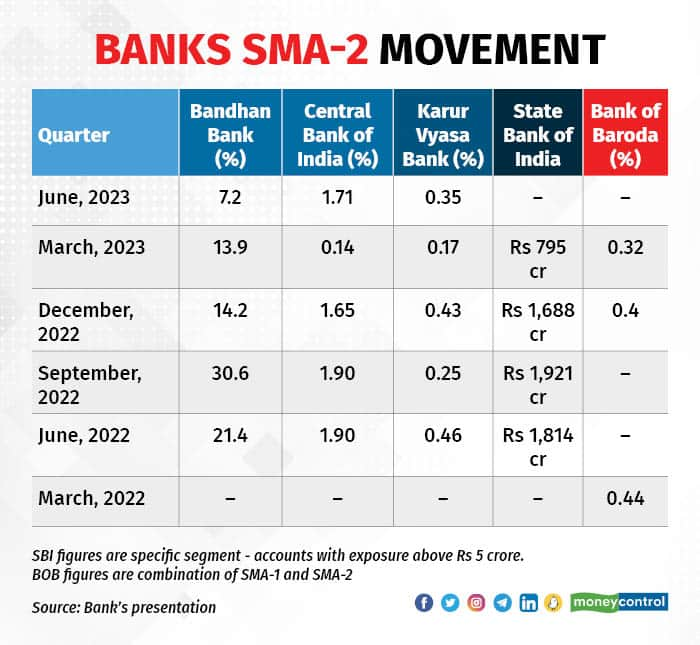



Banks have seen a fall in special mention account (SMA) category 2 loans over the last one year, indicating an improvement in asset quality. SMA 2 loans are loans with overdue payments between 61 and 90 days.
Banks which have reported their first quarter results so far have shown a sharp improvement in this category. They include Bandhan Bank, Central Bank of India, and Karur Vysya Bank.
Other larger banks, such as Bank of Baroda (BoB) and State Bank of India (SBI), had witnessed a similar trend in the previous financial year.
Once an account remains irregular for 90 days, it is classified as a non- performing asset (NPA) or bad loan. Banks have to set aside money to cover such loans, called provisions. This impacts profitability.
“This declining trend in SMA-2 loans is an indication of improving credit quality. Many of the old SMAs have now slipped into NPAs and this area is being cleaned up and fresh credit lending is of higher quality,” said Sanjay Agarwal, Senior Director, CARE Ratings.
The Reserve Bank of India (RBI), in its Financial Stability Report (FSR), said that the improvement in the SMA-2 ratio in March 2023 across bank groups reflected the containment of potential slippages during H2 of 2022-23.
Further, the central bank said that as per the stress test results, gross non-performing assets (GNPAs) ratio of all scheduled commercial banks (SCBs) may improve to 3.6 percent by March 2024 under the baseline scenario.
“If, however, the macroeconomic environment worsens to a medium or severe stress scenario, the ratio may rise to 4.1 percent and 5.1 percent, respectively,” the RBI added.
Adding to this, Nitin Purswani, CEO Medius AI said a noteworthy factor is the adoption of technology by banks, which is facilitating faster and more efficient collections, thereby allowing more timely loan recoveries.
"This technological pivot not only hastens the recovery process but also augments financial stability, ensuring fewer potential NPAs and reinforcing the overall health of the banking sector," Purswani added.
What do numbers say?
According to a Moneycontrol analysis, most banks which have reported the April-June quarter numbers so far have shown improvement in their SMA-2 loans.
Bandhan Bank, in the first quarter of the current financial year, reported 7.2 percent loans in the SMA-2 category, sharply lower than the 21.4 percent in the corresponding quarter last year, according to the bank's ‘investor presentation’.
Similarly, Central Bank of India reported 1.71 percent loans in the SMA-2 category in the June quarter, as compared to 1.90 percent in the last year, and Karur Vysya Bank reported 0.35 percent, as on June 30, compared to 0.46 percent in the year-ago period, showed their presentations.

Other state-owned banks, which have not yet announced Q1FY24 results, such as BoB and SBI, have shown a declining trend in SMA-2 loans in the previous quarters.
According to the FY23 investor presentation, SBI reported Rs 795 crore in SMA-2 category as on March 2023, as against Rs 1,814 crore in the year-ago period, and BoB reported 0.32 percent as on March 2023, as against 0.44 percent in the corresponding period last year.
Improvement in asset quality
The central bank, in its FSR in June 2023, said the asset quality of SCBs improved to a 10-year low, with GNPA declining to 3.9 percent in March 2023.
Similarly, net NPA ratio also improved to 1 percent, a level last observed in June 2011. This is indicative of active and deep provisioning, the report added.
In fact, SCBs’ provisioning coverage ratio improved to 74 percent in March 2023.
“The improvement in the asset quality of SCBs has been broad-based, with a steady decline in stressed advances ratio across all major sectors,” the report said.
The share of large borrowers in gross advances of SCBs declined successively over the past three years from 51.1 percent in March 2020 to 46.4 percent in March 2023, as retail loans grew faster than borrowings by corporates.
The share of large borrowers in the GNPAs of SCBs also came down substantially from 75.7 percent in March 2020 to 53.9 percent in March 2023. Asset quality in the large borrower portfolio saw significant improvement, and the GNPA ratio declined from 12.2 percent to 4.5 percent over this period.
Discover the latest Business News, Sensex, and Nifty updates. Obtain Personal Finance insights, tax queries, and expert opinions on Moneycontrol or download the Moneycontrol App to stay updated!
Find the best of Al News in one place, specially curated for you every weekend.
Stay on top of the latest tech trends and biggest startup news.